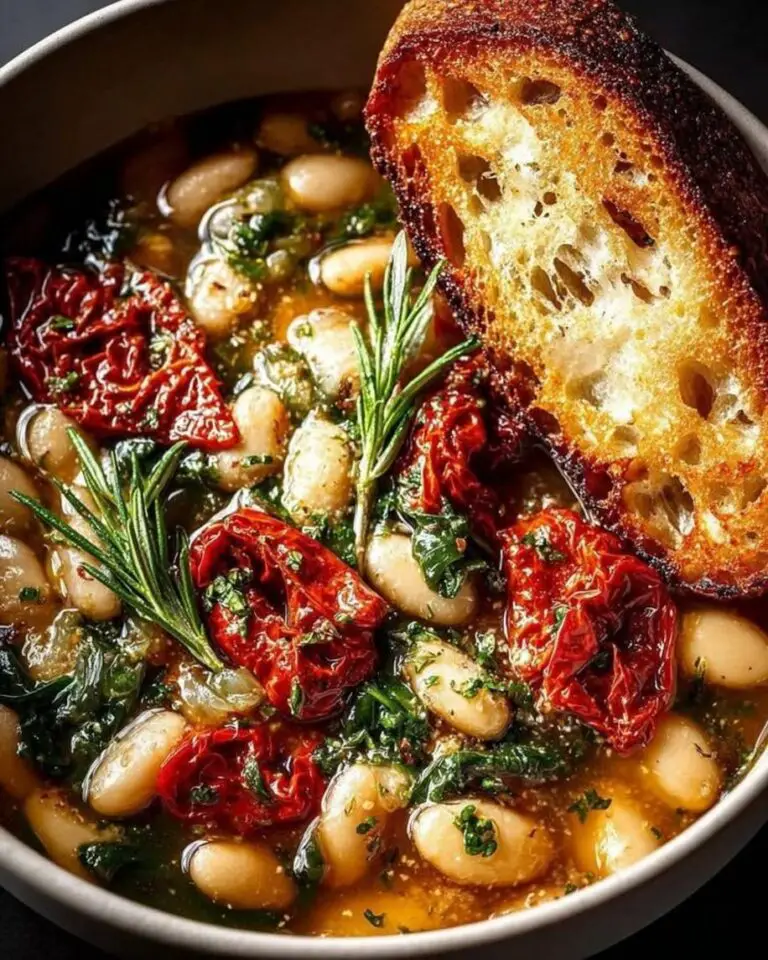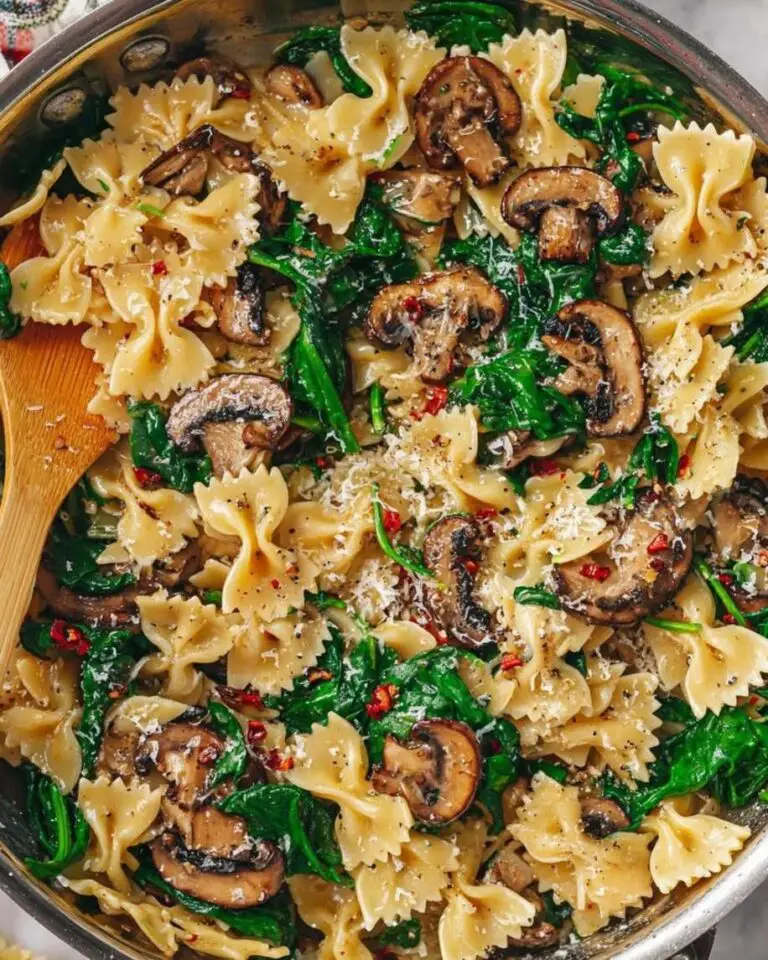Best Creamy White Lasagna Soup with Veggies – Family Favorite

Creamy White Lasagna Soup with Veggies – Ultimate Comfort in a Bowl!
If you are looking for a comforting meal that feels like a warm hug on a chilly evening, then our Creamy White Lasagna Soup with Veggies is the ultimate choice. This delightful recipe combines all the flavors of classic lasagna, from gooey cheese to savory tomato, but in a creamy soup form that is utterly irresistible. Packed with nutritious veggies, this dish not only warms your heart but also nourishes your body, making it perfect for busy weeknights or relaxed weekends.
With its creamy broth and layers of familiar flavors and textures, this lasagna soup will quickly become a family favorite. Imagine a bowl of luscious soup filled with tender noodles, colorful broccoli, and vibrant tomatoes, all topped with a sprinkle of fresh herbs and cheese. It’s the kind of meal that invites everyone to gather around the table, share stories, and enjoy each other’s company.
Quick Recipe Highlights
- Flavor Profile: This soup features a rich, creamy base complemented by tangy tomatoes and the subtle flavors of garlic and herbs, creating a comforting taste experience.
- Texture: The combination of soft noodles, tender vegetables, and a velvety broth provides a delightful mouthfeel that is both robust and satisfying.
- Aroma: As it simmers on the stove, the aroma of garlic and fresh herbs fills the air, making it impossible not to feel excited about this meal.
- Visual Appeal: The vibrant greens of broccoli and the pops of red from tomatoes create a visually stunning dish, making dinner feel like a celebration.
- Skill Level Needed: This recipe is easy enough for beginner cooks, requiring basic chopping and stirring techniques.
- Special Equipment: A large pot is essential for creating the soup, along with standard kitchen tools like a cutting board and knife.
Recipe Overview
- Difficulty Level: This recipe is uncomplicated, making it a great choice for novice cooks who are looking to try something new without feeling overwhelmed.
- Category: Perfect for a main dish, this Creamy White Lasagna Soup with Veggies fits well into any supper or lunch category.
- Cuisine: Drawing inspiration from Italian culinary traditions, this soup brings together classic elements of lasagna in a new and exciting way.
- Cost: The ingredients for this soup are budget-friendly, with an estimated total cost of around $15, making it accessible for families and individuals alike.
- Season: This soup is ideal for cooler months, offering warmth and comfort when the weather turns chilly.
- Occasion: Serve this comforting soup on family game nights, casual gatherings, or even during a cozy night in.
Why You’ll Love This Recipe
This Creamy White Lasagna Soup offers a perfect blend of taste and texture that will delight your taste buds. The creamy broth wraps around each ingredient, creating a harmonious balance that is both rich and comforting. Combining the flavors of traditional lasagna with fresh ingredients like broccoli and tomatoes enhances this dish while keeping it nutritious. Even the pickiest eaters will find it hard to resist a serving of this scrumptious soup.
Convenience is another reason to love this soup. Preparation time is minimal, and the cooking process is straightforward and quick. With just one pot to clean up afterward, it makes for an easy dinner option that won’t consume your entire evening. With everything cooked together in perfect harmony, this soup is both a time-saver and a crowd-pleaser.
The nutritional advantages are also a highlight, with a significant amount of veggies included in the recipe. Packed with vitamins and fiber, each bowl not only satisfies hunger but also provides essential nutrients. This means you can enjoy a delicious meal without feeling guilty about indulging.
Social and entertaining value is something this recipe excels at. It’s perfect for gatherings, as it can easily be scaled up to serve many people. Plus, watching your loved ones dig into a hearty bowl of soup can elevate the sense of warmth and camaraderie during family dinners or friendly get-togethers.
Lastly, the cost-effectiveness of this soup cannot be overlooked. With inexpensive ingredients that are commonly found in your local grocery store, you can whip up a satisfying meal without spending a fortune. This makes it a smart choice for those watching their budget while still wanting to enjoy delightful food.
Historical Background and Cultural Significance
The origin of lasagna can be traced back to ancient Greece, where layers of pasta were combined with vegetables and sauces. Over the years, this delightful dish has evolved, particularly in Italy, where it has become a beloved staple. By transforming lasagna into a soup format, we embrace the essence of this traditional dish while innovating a modern twist. This adaptation reflects the creativity often found in home cooking, merging comfort with convenience.
Culturally, lasagna is more than just a dish; it symbolizes gatherings and family traditions, often served during special occasions and holidays. The creamy white lasagna soup pays homage to these traditions while allowing for new interpretations. It bridges generations, encouraging families to gather around the table, sharing laughter and stories as the soup simmers on the stove.
This recipe has evolved to cater to varied dietary needs and tastes, showcasing the versatility of lasagna. Whether for a hearty family dinner or a quick lunch, the adaptation into soup format allows it to reach new audiences who might not usually gravitate towards traditional lasagna.
Regional variations now exist beyond just Italy, reflecting local ingredients and preferences. This Creamy White Lasagna Soup can spark discussions about ingredients, cooking styles, and family traditions, bringing people together in both the kitchen and at the table.
Ingredient Deep Dive
Lasagna noodles serve as the foundational ingredient for this soup. These versatile sheets add texture and substance, mimicking the layers of traditional lasagna. Nutritionally, they provide carbohydrates that offer energy and contribute to the dish’s overall heartiness. When selecting lasagna noodles, look for those made from whole grains, which add fiber. Store them in a cool, dry place, and consider using gluten-free options if dietary restrictions warrant.
Fresh vegetables like broccoli and tomatoes not only add vibrant colors but also pack in essential vitamins and minerals. Broccoli is rich in Vitamin C, K, and fiber, while tomatoes bring lycopene, an antioxidant known for its health benefits. When choosing vegetables, opt for organic when possible, and consult local farmers’ markets for the freshest selections. Store these in the fridge, and use them promptly to retain their nutritional benefits. Substitutions such as spinach or zucchini can also be effective, depending on what you have on hand.
Common Mistakes to Avoid
- Overcooking the noodles: Ensure the noodles are cooked al dente, as they will continue to soften in the soup. Checking time is crucial, as mushy noodles can ruin the texture.
- Not seasoning enough: A common error is under-seasoning the broth, which may leave the soup lacking in flavor. Use salt and herbs generously to enhance the taste.
- Skipping veggie prep: Prepping your vegetables properly can make a big difference. Chopping them finely and distributing them evenly helps create a balanced taste.
- Adding all ingredients at once: To achieve the best flavor, add ingredients like garlic and herbs at different stages. This builds depth in the broth.
- Using low-quality cheese: Cheese enhances flavor and creaminess, so opt for a good-quality cheese that melts well for the best results.
- Neglecting to stir: Stirring occasionally prevents ingredients from sticking to the bottom and ensures that the flavors meld together beautifully.
- Rushing the cooking process: Allow the soup ample time to simmer; this is when the flavors deepen and develop fully. Patience is key!
- Improper storage: If you have leftovers, ensure that they are cooled before placing them in airtight containers. This helps maintain freshness and prevents spoilage.
- Ignoring dietary preferences: When serving guests, consider dietary restrictions and offer variations so that everyone can enjoy the soup.
- Not tasting as you go: Always taste your soup as it cooks! This allows you to adjust seasonings and ingredients, ensuring the best final flavor.
Essential Techniques
Sautéing vegetables is crucial for enhancing the flavors in this soup. This technique helps release natural sugars and oils from the vegetables, creating a fragrant base for your broth. To master sautéing, always preheat your pan before adding oil and ensure the ingredients are dry to prevent steaming. Look for a golden-brown color as a visual cue for perfectly sautéed vegetables.
Layering flavors is another essential technique. Sauté your garlic and onion first before adding the other ingredients to develop a rich, aromatic base. Gradually incorporate broth and noodles, allowing each ingredient to shine while enhancing the overall dish. Mistakes can include adding everything at once; instead, add ingredients in stages to build a harmonious blend of flavors.
Pro Tips for Perfect Creamy White Lasagna Soup
Start with a quality broth as it sets the foundation for your soup’s flavor. Homemade broth will elevate the dish. If using store-bought, consider low-sodium options to control the salt level.
Add fresh herbs toward the end of cooking to capture their bright flavors. Sprinkling fresh basil or parsley just before serving can enhance the dish immensely.
Don’t skimp on cheese! A generous amount of cheese not only contributes creaminess but also elevates the texture and taste. Opt for a blend of cheeses for depth of flavor, like ricotta and mozzarella.
If you like a bit of spice, consider adding red pepper flakes or a dash of hot sauce to the soup for an extra kick. This will add a new dimension to the comforting flavor profile.
Use extra-virgin olive oil for drizzling before serving. It adds a deliciously fruity note to finish off the soup.
Shop seasonal vegetables for the freshest taste. Depending on the season, try adding butternut squash in fall or zucchini in summer to keep the recipe seasonal and adjusted to ingredients on hand.
For those who love a more robust flavor, consider browning sausage or chicken before adding the vegetables. This will impart rich savory notes into your soup that complement the overall flavor.
Lastly, if the soup is too thick after cooking, add more broth or water to adjust the consistency to your preference.
Variations and Adaptations
Regional variations might include different types of cheese – for example, provolone or gorgonzola – which would add unique flavors to the dish. Additionally, you could incorporate regional veggies like kale or bell peppers based on local availability.
Seasonal adaptations can yield exciting results; in the summer, fresh corn could be added to brighten the flavor and enhance the soup’s sweetness. Opting for seasonal ingredients ensures freshness and optimizes flavors.
For dietary modifications, use plant-based dairy substitutes or gluten-free noodles to keep the essence of the dish accessible to those with dietary restrictions. You can easily transform this into a vegan-friendly soup by swapping to veggie broths and omitting cheese.
For flavor variations, try adding pesto to the mix for a fresh flair, or experiment with different herbs like thyme or rosemary for a change in profile.
If you are looking for texture modifications, consider blending a portion of the soup for a creamy base while keeping some chunkiness for added interest.
Presentation can also be adapted; serve in large bowls and add crusty bread for a classic touch, or elevate it with a drizzle of truffle oil and a sprinkle of microgreens for a gourmet feel.
Serving and Presentation Guide
When plating the Creamy White Lasagna Soup, consider using a wide-bowl to showcase the layers. This allows for a visually appealing presentation that invites diners to dig in. To enhance visual appeal, garnish each bowl with fresh herbs and a sprinkle of cheese.
For garnishing, thin slices of basil or chopped parsley add a pop of color, while a few dollops of ricotta cheese can enhance the creamy aspect and provide textural contrast.
Pairing the soup with a side of crusty bread or garlic bread is traditional and allows for a wholesome meal. Guests can enjoy dipping the bread into the rich broth.
Served warm, this soup is enticing. If your soup has thickened too much, adjust the consistency before serving for the best experience. Decant into bowls directly from the pot to keep it piping hot!
For portion control, consider serving smaller bowls if it is part of a multi-course meal. This helps balance the entire dining experience without overwhelming guests.
Wine and Beverage Pairing
For perfect wine pairings, a crisp white wine like Pinot Grigio complements the creamy notes of the soup beautifully, as its acidity balances the flavors. Alternatively, a light-bodied red, such as Chianti, can pair well with the tomato components.
Non-alcoholic alternatives include sparkling water with a splash of lemon, which can refresh the palate. Additionally, herbal iced teas served chilled create a nice contrast with the warm soup.
If tea or coffee is more suited to your tastes, a robust black tea can also marry well with the richness of the dish, providing a comforting after-dinner option.
Ensure that wine and beverages are served at the right temperatures to maximally enhance flavor; whites chilled and reds served slightly below room temperature will ensure a delightful dining experience.
Storage and Shelf Life
Stored properly, Creamy White Lasagna Soup can stay fresh for up to 3-4 days in the refrigerator. Allow it to cool before transferring it to an airtight container to maintain its quality.
The optimal temperature for storage is around 40°F or below. Reheating should be done gradually over low heat on the stove, stirring frequently to retain creaminess, or in the microwave with a few splashes of broth to revive the soup’s consistency.
For longer storage, consider freezing the soup. Portion it out into freezer-safe containers and label with the date. It can be frozen for up to 2-3 months without losing much quality, just ensure you reheat it thoroughly before enjoying.
Signs of spoilage to look out for include an off smell, discoloration, or a change in texture. When reheating, if something seems off, it’s best to err on the side of caution and discard it.
Make Ahead Strategies
You can prep some elements of this soup during the day prior to cooking. Chop your veggies and store them in the fridge. This saves time in the evening when you plan to make the soup.
Consider cooking the broth the day prior too, which allows the flavors to deepen overnight. Just reheat it before adding noodles and veggies to save cooking time.
Assess the quality impact when making components in advance. Some flavors may intensify when combined and left overnight together; however, remember to add fresh herbs and cheese just before serving for the best results.
When assembling, don’t hesitate to layer, as putting together lasagna-style can add visual appeal as well as texture in each bowl. It’s perfectly fine to follow the directions closely while also getting creative with assembly.
When ready to serve, just reheat gently and add any fresh ingredients. This ensures your soup tastes like it was just made, brightening the flavors before enjoying.
Scaling Instructions
If you need to halve the recipe, simply reduce the number of each ingredient accordingly. This soup is easily adaptable as it can scale down without losing flavor.
To double or triple the batch, use larger pots and take care not to crowd the ingredients. This may necessitate longer cooking times, particularly for noodles, so be sure to monitor doneness closely.
Adjust your equipment needs when scaling, opting for larger pots and ensuring there’s ample cooking space to prevent ingredients from steaming rather than sautéing.
Timing modifications are also important; when making larger batches, allow additional time for the broth to come to a simmer and to ensure even cooking throughout the soup.
For storing leftovers from a double batch, opt for more containers to keep individual servings fresh, as they maintain quality without taking space in your refrigerator.
Nutritional Deep Dive
The macro breakdown of this soup showcases a balanced mix of carbohydrates from the noodles, protein from cheese, and plenty of fiber from vegetables. The dish is great for energy without feeling heavy.
Micronutrient analysis reveals a wealth of vitamins from the tomatoes and broccoli, offering Vitamin C, K, and antioxidants. This richness contributes to overall health benefits.
With careful ingredient selection, this soup can be modified to meet various dietary needs while still providing nourishing options. It makes for an excellent meal choice for weight management when enjoyed in moderation.
Portion analysis is crucial for maintaining balance. Given its heartiness, the soup is satiating; determine serving sizes before plating to avoid overeating.
For weight management tips, monitor ingredients incorporated to enhance nutritional value, possibly swapping out heavy creams for lighter options while still retaining creaminess. This allows indulgence without too much guilt.
Dietary Adaptations
For gluten-free adaptations, always choose gluten-free lasagna noodles or opt for alternative grains like quinoa or brown rice to maintain texture.
Dairy-free options can be achieved using nut or coconut-based cheeses, which provide creamy textures while avoiding lactose. Additionally, cream can be substituted with almond milk or oat milk for a lighter version.
For vegan variations, omit all dairy and use plant-based noodles and vegetable broth, ensuring a completely vegan-friendly experience without sacrificing flavor.
Low-carb adaptations might include zucchini noodles or cauliflower rice instead of traditional noodles, providing a healthier option while still staying true to the soup’s essence.
For ketogenic diets, use high-fat cheese and full-fat coconut milk to ensure you’re getting enough healthy fats while minimizing carbohydrates from noodles.
Paleo-friendly versions could swap noodles for spiralized veggies like squash, creating a nourishing and whole-food substitute that retains the soup’s heartiness.
Low-FODMAP options would require omitting high-FODMAP ingredients like onions and garlic, substituted with allowed vegetables while preserving overall flavor.
Troubleshooting Guide
Texture issues can arise from overcooked noodles. Always be cautious to check noodles a minute or two before the recommended time to achieve the right consistency.
Flavor balance adjustments may be necessary if the soup tastes bland. Suggested additions include more herbs or spices to enhance overall taste without overwhelming the base.
If you face temperature problems with your soup being too cold, gently reheat it over low heat. Adding a few more broth or milk can help smooth out any texture issues that might arise.
Equipment challenges, such as a pot that doesn’t fit all the ingredients, can be avoided by preparing ingredients in smaller pots. Alternatively, consider cooking ingredients in batches and combining them later.
For ingredient substitutions, if something is missing, don’t hesitate to experiment with similar flavors and textures, such as swapping out noodles for vegetables to maintain bulk.
Timing concerns around meal prep can be fixed by chopping vegetables at the beginning of your day. Setting a timer for various cooking stages can keep everything organized to prevent any delays.
Recipe Success Stories
Community feedback has been overwhelmingly positive, with readers praising the ease of preparation as well as the comforting flavors that remind them of family dinners. Many have shared personal adaptations to suit their tastes, making this recipe their own.
Successes with variations, such as including roasted vegetables or different cheeses, have inspired others to get creative in the kitchen. These adaptations keep the recipe fresh and exciting!
Adaptation stories often highlight experiences with picky eaters; parents report that their children loved this soup, with easy vegetable incorporation leading to healthier families.
Photography tips shared among the community have shown beautiful presentations of the soup, from ingredient layout to flawless garnishing techniques that elevate the dish in visual appeal for social media sharing.
Frequently Asked Questions
Can I freeze Creamy White Lasagna Soup?
Yes, you can freeze the soup. Ensure it’s cooled completely before transferring to freezer-safe containers, and it will last for up to 3 months.
What can I replace lasagna noodles with?
You can use gluten-free noodles, zucchini noodles, or even spiralized vegetables for a low-carb alternative in this soup.
How do I make the soup spicier?
Add red pepper flakes or sliced jalapeños while cooking for added heat; adjust to your preferred spice level.
Can I use different vegetables?
Absolutely! Feel free to experiment with seasonal vegetables like spinach, kale, or bell peppers based on what you have available.
Is this soup vegan-friendly?
You can easily make this soup vegan by using plant-based cheese and broth while omitting any dairy products.
How long will leftovers last in the fridge?
Leftover soup can stay fresh in the refrigerator for about 3-4 days if stored properly in an airtight container.
Can I use store-bought broth?
Yes, store-bought broth is a convenient option. Opt for low-sodium varieties for better flavor control.
What’s the best way to reheat the soup?
Reheat gently on the stove over low heat, stirring often, or microwave in short bursts with intermittent stirring until hot.
How can I make it creamier?
For a creamier texture, consider adding more cheese or substituting some broth with heavy cream or a dairy-free cream alternative.
Can I prepare this dish in advance?
Yes, you can pre-chop vegetables and even prepare the broth a day in advance. Just combine and cook when you’re ready to serve.
Additional Resources
For those looking to expand their culinary repertoire, consider exploring related recipes such as Vegetarian Chili or Chicken Noodle Soup for hearty, comforting meals. Technique guides for sautéing vegetables and making homemade broth can enhance your cooking skills while elevating this soup.
Ingredient information is crucial for understanding how to choose the best products for your soup. Consider delving into quality cheeses and fresh herbs for maximum flavor. Equipment recommendations, like using a Dutch oven for optimal heat distribution, can make your cooking experience even easier.
For seasonal variations, transitioning the soup ingredients according to produce availability can keep your meals fresh throughout the year, adjusting to every palate and preferences as they change.
Join the Conversation
We would love to hear about your experience with this recipe! Share your own twists and variations on social media, and be sure to tag us in your posts or use our recipe hashtag.
Photography enthusiasts can submit their soup presentations for a chance to be featured on our blog! Recipe reviews and suggestions are always welcomed – let’s engage and inspire each other during our cooking adventures.
Join our community discussions on how you’ve adapted the Creamy White Lasagna Soup and connect with fellow food lovers to explore new ideas. Together, we can cultivate an environment where creativity in cooking thrives.
The Recipe
Creamy White Lasagna Soup with Veggies
Serves: 6
Prep Time: 15 mins
Cook Time: 30 mins
Total Time: 45 mins
Kitchen Equipment Needed
- Large pot
- Cutting board
- Sharp knife
- Measuring cups
- Wooden spoon
Ingredients
- 8 oz. lasagna noodles, broken
- 1 tbsp olive oil
- 1 onion, diced
- 3 cloves garlic, minced
- 4 cups vegetable broth
- 1 can (14 oz.) diced tomatoes
- 2 cups broccoli florets
- 1 tsp dried basil
- Salt and pepper to taste
- 1 cup ricotta cheese
- 1 cup shredded mozzarella cheese
- Fresh basil for garnish
Directions
- In a large pot, heat olive oil over medium heat. Add onion and garlic, and sauté until translucent.
- Add the vegetable broth, diced tomatoes, broken lasagna noodles, broccoli, dried basil, salt, and pepper. Bring to a simmer.
- Cook for about 20 minutes or until the noodles and broccoli are tender.
- Stir in ricotta and half of the mozzarella cheese until melted and creamy.
- Serve hot, garnished with remaining mozzarella and fresh basil.
Recipe Notes
- Feel free to substitute lasagna noodles with gluten-free or zucchini noodles.
- This soup can be made ahead and frozen for later. Thaw and reheat on the stove.
- Add your favorite vegetables to customize the soup to your liking.
- Adjust the cheese amounts according to your preference for creaminess.






